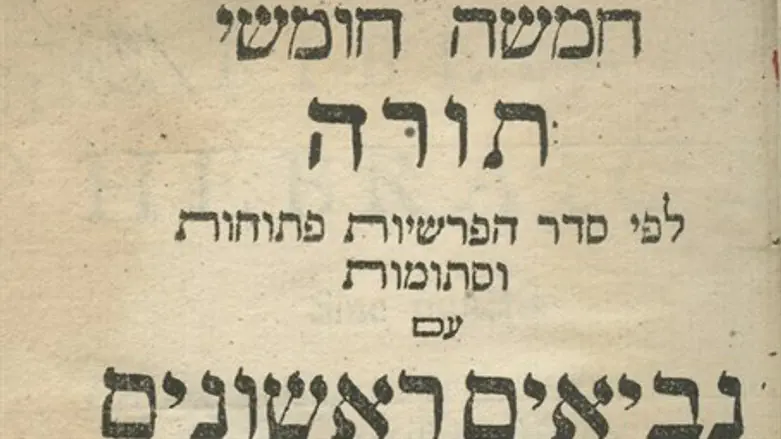
An antique Bible printed in Amsterdam in 1701 is being put up for auction in three weeks' time. This particular edition is remarkable because it was used several times to perform the 'Goral Ha-Gra' ('lottery of the Vilna Gaon').
This lottery, attributed to the Vilna Gaon (Rabbi Elijah Kramer, 1720 – 1797) is actually first mentioned over 200 years earlier in a book by Rabbi Saul Sirero. It is a method for resolving rare and important dilemmas. There is a specific tradition of turning pages of the Bible a certain number of times at random until one reaches a particular verse, which will provide the answer.
According to tradition only this edition of the Bible may be used for performing this lottery because it is printed with two columns on each page, which is a necessary requirement.
It was this edition of the Bible that was famously used by Rabbi Arieh Levin when he performed the 'Goral Ha-Gra' to identify the remains of unidentified soldiers from the 'lamed-heh' ('convoy of 35').
The 'lamed-heh' set out on 16 January 1948 to bring supplies to the four blockaded kibbutzim of Gush Etzion. They were discovered and ambushed by an Arab horde and their bodies were mutilated. These bodies were recovered by the British soldiers stationed in Hebron and were buried in temporary graves in Gush Etzion. After the fall of Gush Etzion, the details of who was buried in each grave were lost.
In 1950 the bodies were brought to Jerusalem for burial. The parents of the fallen soldiers turned to Rabbi Tzvi Pesach Frank to help them identify their sons. He sent them to Rabbi Aryeh Levin who performed the 'Goral Ha-Gra' to identify the bodies.
Rabbi Aryeh Levin at first refused to perform the lottery because it may only be used in very rare circumstances. However, he eventually agreed.
Simcha Raz writes in his biography of Rabbi Aryeh Levin, A Tzaddik in Our Time: "In order to perform the lottery, one may only use a Bible printed in two columns. An antique Bible printed in Amsterdam in 1701... with yellowing but still complete pages, any tears patched with clear tape to keep the layout intact.
"The identification took place in Levin's beit midrash (study hall), in the presence of representatives of the bereaved parents. Twelve candles were lit, the Bible was opened at random seven times and Rabbi Levin ruled that as they stood in front of the remains of each of the fallen fighters, the last verse on the page had to include the name, or an allusion to the name, of each of those whom they were trying to identify.
"How amazed everyone was when one of the verses that first appeared was 'The earth is the Lord's, and the fullness thereof; the world, and they that dwell therein,' (Tehillim 24:1) a verse that [in Hebrew] begins with the word 'to the Lord,'" which is abbreviated in Hebrew with the initials lamed-heh ('thirty-five'). "Moreover, to everyone's amazement, every page spoke unequivocally. In the first verse they reached there was a specific name that clearly identified one of the fallen ... One after the other ... the identity of the fallen was determined."
Rabbi Aryeh Levin had received the tradition of how to perform this lottery from his Rabbis in a chain of tradition stretching back to the Vilna Gaon.
This lottery was also performed by Rabbi Aharon Kotler when he wanted to leave Russia to move to Israel. However Rabbi Moshe Feinstein was pressuring him to move to the USA instead in order to strengthen Jewish life in that spiritual 'wilderness.' When he performed the lottery, Rabbi Kotler arrived at the verse, "God said to Aharon, 'Go to meet Moshe in the wilderness'" (Shemot 4:27). He understood the message and moved to the USA.
The Bible is being auctioned by Kedem Auction House along with hundreds of other manuscripts and rare books.
Meron Eren of the Kedem Auction House in Jerusalem stresses that one must be careful "not to perform the 'Goral Ha-Gra' without good cause. Precisely for this reason, this book has unique historical significance. Bibles like this have been used by Jews throughout the generations to resolve truly difficult and crucial dilemmas, in order to decide how to act and to know what to do."